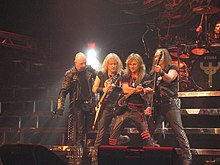
Judas Priest, performing in 2005
Critic Simon Frith claims that the metal singer's "tone of voice" is more important than the lyrics. Metal vocals vary widely in style, from the multioctave, theatrical approach of Judas Priest's Rob Halford and Iron Maiden's Bruce Dickinson, to the gruff style of Motörhead's Lemmy and Metallica's James Hetfield, to the growling of many death metal performers, and to the harsh screams of black metal.
The prominent role of the bass is also key to the metal sound, and the interplay of bass and guitar is a central element. The bass guitar provides the low-end sound crucial to making the music "heavy". Metal basslines vary widely in complexity, from holding down a low pedal point as a foundation to doubling complex riffs and licks along with the lead and/or rhythm guitars. Some bands feature the bass as a lead instrument, an approach popularized by Metallica's Cliff Burton in the early 1980s.
The essence of metal drumming is creating a loud, constant beat for the band using the "trifecta of speed, power, and precision". Metal drumming "requires an exceptional amount of endurance", and drummers have to develop "considerable speed, coordination, and dexterity...to play the intricate patterns" used in metal. A characteristic metal drumming technique is the cymbal choke, which consists of striking a cymbal and then immediately silencing it by grabbing it with the other hand (or, in some cases, the same striking hand), producing a burst of sound. The metal drum setup is generally much larger than those employed in other forms of rock music.
In live performance, loudness—an "onslaught of sound," in sociologist Deena Weinstein's description—is considered vital. In his book Metalheads, psychologist Jeffrey Arnett refers to heavy metal concerts as "the sensory equivalent of war." Following the lead set by Jimi Hendrix, Cream and The Who, early heavy metal acts such as Blue Cheer set new benchmarks for volume. As Blue Cheer's Dick Peterson put it, "All we knew was we wanted more power." A 1977 review of a Motörhead concert noted how "excessive volume in particular figured into the band's impact." Weinstein makes the case that in the same way that melody is the main element of pop and rhythm is the main focus of house music, powerful sound, timbre, and volume are the key elements of metal. She argues that the loudness is designed to "sweep the listener into the sound" and to provide a "shot of youthful vitality."
Musical language
Rhythm and tempo

An example of a rhythmic pattern used in heavy metal. The upper stave is a palm-muted rhythm guitar part. The lower stave is the drum part.
Brief, abrupt, and detached rhythmic cells are joined into rhythmic phrases with a distinctive, often jerky texture. These phrases are used to create rhythmic accompaniment and melodic figures called riffs, which help to establish thematic hooks. Heavy metal songs also use longer rhythmic figures such as whole note- or dotted quarter note-length chords in slow-tempo power ballads. The tempos in early heavy metal music tended to be "slow, even ponderous." By the late 1970s, however, metal bands were employing a wide variety of tempos. In the 2000s decade, metal tempos range from slow ballad tempos (quarter note = 60 beats per minute) to extremely fast blast beat tempos (quarter note = 350 beats per minute).
No comments:
Post a Comment